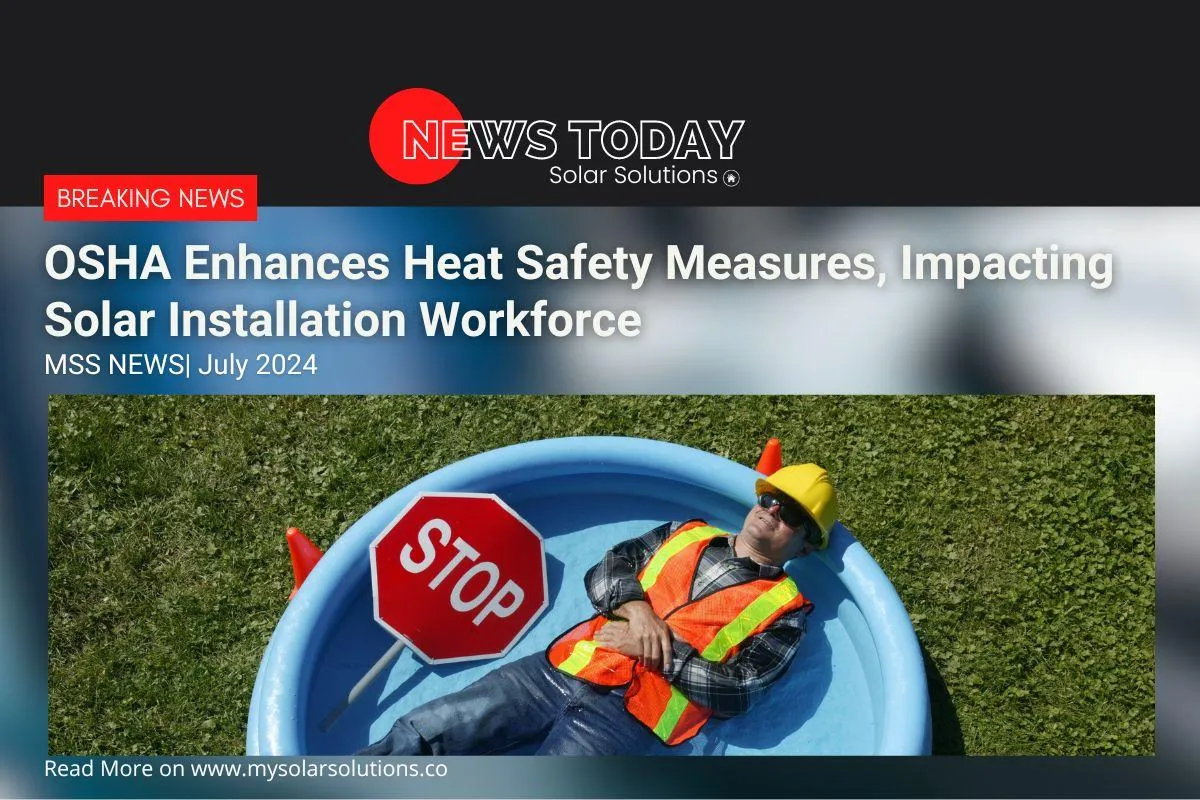The Solar Industries Trusted News Source
Solar News Today
Transparent Reporting for a Sustainable Future
Latest News Stories

OSHA Enhances Heat Safety Measures, Impacting Solar Installation Workforce
Protecting Workers from Extreme Heat
As climate change drives up global temperatures, extreme heat events are becoming more frequent and severe. These conditions pose serious health risks to workers, especially those in outdoor or non-climate-controlled environments. Recognizing the urgent need for enhanced protective measures, the Occupational Safety and Health Administration (OSHA) has implemented new standards to safeguard workers from the dangers of extreme heat. This article explores the implications of these standards and what they mean for workers and employers nationwide.
Climate Change and Heat Waves: A Growing Concern
In recent years, climate change has exacerbated the frequency and intensity of heat waves. Scientists attribute this trend to global warming, which has led to record-breaking temperatures across various regions. The impact of extreme heat is not just limited to the environment; it significantly affects human health and productivity. Heat stress can lead to severe conditions like heat exhaustion and heat stroke, which can be fatal if not addressed promptly. As the number of extreme heat days increases, so does the risk to workers who are exposed to these hazardous conditions.
Vulnerable Worker Populations: Who is at Risk?
Certain groups of workers are particularly vulnerable to the effects of extreme heat. These include construction workers, agricultural laborers, delivery personnel, and others whose jobs require prolonged exposure to high temperatures. Additionally, workers in indoor settings without adequate cooling systems are also at risk. Vulnerability is further heightened for older workers, those with preexisting health conditions, and individuals who are new to working in high-heat environments. OSHA's new standards aim to address these vulnerabilities by mandating comprehensive protective measures.
How Solar Installers Will Be Impacted By OSHA Protocols:
The strengthened OSHA protocols for safeguarding workers in extreme heat conditions will have significant implications for solar installers, particularly during the sweltering summer months. Solar installers, who often work on rooftops and exposed outdoor environments, are especially vulnerable to heat-related illnesses such as heat exhaustion and heat stroke. The new OSHA guidelines will require employers to implement comprehensive Heat Illness Prevention Plans (HIPP), which include providing ample hydration, shaded rest areas, and ensuring proper acclimatization. This may result in increased costs for employers to meet compliance, as well as potential adjustments to work schedules to avoid peak heat hours. Despite these challenges, these measures are crucial for the well-being and safety of solar installers, ultimately leading to healthier, more productive workers and a reduction in heat-related incidents on the job.
OSHA's New Standards: An Overview
One of the cornerstone requirements under OSHA's updated guidelines is the development and implementation of Heat Illness Prevention Plans (HIPP). These plans require employers to establish preventive measures, including adequate hydration, shaded rest areas, and acclimatization protocols for workers new to high-heat conditions. Employers must also provide training on recognizing and responding to heat-related illnesses. By adopting a proactive approach, these plans aim to mitigate the risk of heat stress before it leads to serious health issues.
Monitoring Heat Conditions: Ensuring Workplace Safety
OSHA also emphasizes the importance of monitoring workplace heat conditions. This entails regular measurement of temperature and humidity levels to assess the heat index, a more comprehensive indicator of heat stress risk than temperature alone. Employers are encouraged to use tools such as the OSHA-NIOSH Heat Safety Tool app, which provides real-time heat index values and appropriate protective measures. By staying informed about current heat conditions, employers can make informed decisions to enhance workplace safety.
Emergency Response Protocols: Preparedness and Action
In addition to preventive measures, OSHA's standards underscore the necessity of robust emergency response protocols. Employers must have clear procedures in place for responding to heat-related emergencies, including rapid cooling methods and immediate medical attention. These protocols should be well-communicated and rehearsed to ensure swift and effective action when needed. By prioritizing emergency preparedness, employers can reduce the potential for serious heat-related health incidents.
Employer Responsibilities and Compliance
Training and Education: Building a Knowledgeable Workforce
Education and training are essential components of OSHA’s approach to mitigating heat-related risks. Employers are required to educate their workforce about the dangers of extreme heat and best practices for prevention and response. This training should cover recognizing symptoms of heat stress, understanding the importance of hydration, and knowing how to use shade and rest breaks effectively. A well-informed workforce is better equipped to protect itself and take appropriate action when necessary.
Record keeping and Reporting: Accountability and Transparency
To ensure compliance with the new standards, OSHA mandates diligent recordkeeping and reporting practices. Employers must document their HIPP, training sessions, and any incidents of heat-related illnesses. Regular reporting to OSHA is also required, providing transparency and accountability. These practices enable OSHA to monitor the effectiveness of the standards and make necessary adjustments to protect workers' health continuously.
Challenges and Future Directions: Balancing Costs and Health Benefits
Implementing OSHA's new standards may present certain challenges for employers. The costs associated with developing and maintaining prevention plans, providing training, and ensuring compliance can be substantial, particularly for small businesses. However, these costs must be weighed against the significant health benefits and potential reduction in worker compensation claims. Ultimately, investing in worker safety can lead to higher productivity and job satisfaction in the long run.
Adapting to Climate Change: Long-Term Strategies
As climate change continues to influence weather patterns, the need for robust and adaptive worker safety measures becomes increasingly critical. OSHA's new standards represent a significant step towards addressing the immediate risks posed by extreme heat. However, long-term strategies must also be developed to enhance worker safety sustainably. This includes investing in innovative cooling technologies, redesigning work schedules to avoid peak heat periods, and promoting broader climate action to mitigate global warming.
A Commitment to Worker Safety
OSHA's enhanced standards mark a pivotal advancement in protecting workers from the escalating threat of extreme heat. By prioritizing prevention, monitoring, and preparedness, these measures provide a comprehensive framework to safeguard worker health in increasingly hazardous conditions. As the climate crisis persists, the commitment to worker safety must remain unwavering, ensuring that every worker can perform their duties without compromising their well-being.
MEET THE FOUNDER & CEO
Hey, I'm Kiara!
I bring over a decade of experience in the solar industry, combined with a background in Journalism, to inform and empower others.
As the founder of the largest virtual solar brokerage in America, my mission is to provide transparency and clarity to the world of renewable energy.
Welcome to the news page of My Solar Solutions, your premier source for comprehensive solar news in the United States. We are dedicated to delivering the latest insights, updates, and innovations from the solar energy sector. As the nation's go-to platform for solar information, we cover everything from cutting-edge technologies to policy changes and market trends, ensuring that our audience stays informed and empowered to make decisions about renewable energy
Why Solar News Matters
The solar industry is a dynamic and rapidly evolving field. From breakthroughs in photovoltaic technology to shifts in government incentives, staying updated is essential for homeowners, businesses, and industry professionals alike. Solar energy is at the forefront of the global transition to sustainable power, making it a key player in addressing climate change and reducing reliance on fossil fuels. At My Solar Solutions, we recognize the critical role that information plays in shaping this transition. By providing reliable, accurate, and timely news, we aim to be the trusted source for anyone seeking to understand or engage with the solar industry. Whether you're a homeowner considering solar panels, a business exploring energy-saving solutions, or an enthusiast keen on the latest trends, our news page has something for you.

What We Cover...

Technological Innovations
Solar technology is advancing at an unprecedented pace. Our news page features updates on groundbreaking developments, including:
High-efficiency panels: Learn about the latest solar panels, including advancements in materials like perovskite and bifacial designs.
Energy storage: Discover innovations in battery technologies that enhance the reliability and scalability of solar systems.
Smart grids: Stay informed about how solar integrates with smart grid systems to optimize energy distribution.

Market Trends and Analysis
Understanding market dynamics is crucial for anyone involved in solar energy. Our articles delve into:
Solar adoption rates: Explore data on how solar installations are growing across residential, commercial, and industrial sectors.
Pricing trends: Get insights into the costs of solar panels, inverters, batteries, and installation services.
Investment opportunities: Stay ahead with information about renewable energy stocks, tax credits, and financial incentives.

Policy and Legislation
Solar energy thrives on supportive policies. Our coverage includes:
Federal and state incentives: Learn about tax credits, rebates, and grants available to solar adopters.
Regulations: Understand net metering policies, permitting processes, and compliance requirements.
Global policies: Discover how international agreements and policies impact the U.S. solar industry.

Environmental Impact
Solar energy plays a pivotal role in reducing greenhouse gas emissions and combating climate change. Our content highlights
Carbon savings: Quantify the environmental benefits of switching to solar energy.
Sustainability practices: Explore how solar aligns with broader environmental and sustainability goals.
Case studies: Read about successful projects that showcase the positive impact of solar energy on communities and ecosystems.

Solar Success Stories
Real-world applications of solar energy inspire and inform. We feature:
Residential installations: See how homeowners are transforming their energy usage with solar panels.
Business case studies: Learn about companies leading the charge in renewable energy adoption.
Community projects: Discover how solar energy is empowering underserved regions and creating jobs.

Challenges and Solutions
While solar energy offers numerous benefits, challenges remain. We address issues like:
Grid reliability: Explore how solar interacts with aging grid infrastructure.
Material sourcing: Understand the sustainability concerns related to raw materials for solar panels and batteries.
End-of-life management: Learn about recycling and disposal solutions for solar equipment.
Why Choose My Solar Solutions for Your Solar News?
We take pride in delivering:
Expertise: With over a decade of experience in the solar industry, we bring unparalleled knowledge to our reporting.
Accuracy: Our content is meticulously researched and verified to ensure reliability.
Relevance: We focus on topics that matter most to our audience, from homeowners to industry professionals.
Our commitment to quality has earned us a reputation as the authoritative source for solar news in the U.S. By choosing My Solar Solutions, you are choosing a partner dedicated to your energy independence and environmental stewardship
Our Vision For The Future
At My Solar Solutions, our vision extends beyond providing news. We aim to:
Advocate for policy changes: Support initiatives that make solar energy more accessible and affordable.
Drive innovation: Partner with industry leaders to bring the latest technologies to market.
Promote sustainability: Champion practices that prioritize environmental health and resource conservation.
By aligning with these goals, we strive to create a platform that not only informs but also inspires action.


Facebook
Instagram
X
Youtube